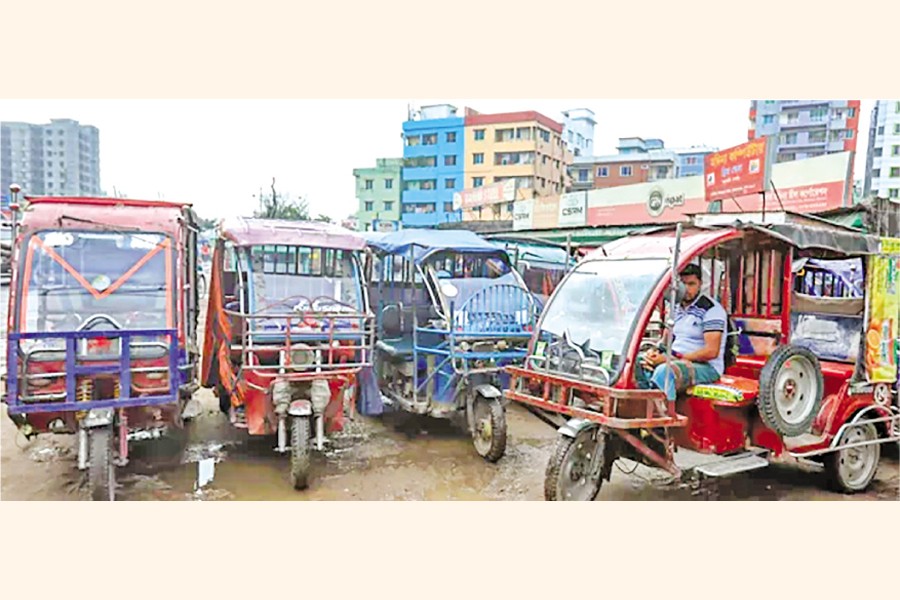
Published :
Updated :

The proliferation of auto-rickshaws has reached the tipping point where their earlier version of pedal rickshaws is on the verge of vanishing from the scene. Electricity stored in a battery pack through charging turns a motor into mechanical power to drive the three-wheelers. This is why the vehicle is also called electric or e-rickshaws. The transportation landscape of Dhaka has undergone a transformation of menacing order, courtesy of the proliferation of these three-wheelers.
Admittedly, these eco-friendly vehicles have several advantages over the traditional pedicabs powered by human power. They are eco-friendly, faster and need no back-breaking labour by their drivers to operate. Actually, the first batch of auto-rickshaw arrived as early as 2007 from China. Known as easy bikes, these vehicles now ply, alongside rickshaw vans, the narrow roads of rural Bangladesh. No, easy bikes could not stay in competition in the capital but in Cox's Bazar and Sylhet, two highly popular tourist spots, they have endured because of their affordability, languid movement and structural openness to offer a wide view of panorama on both sides.
Dhaka has witnessed a highly chaotic growth of three-wheelers on its streets. Local craftsmen have fashioned crude versions of three-wheelers of all shapes and sizes. At a time when a crude and inconvenient type of three-wheelers hit the streets of the city peripheries of Uttara and other areas, the traffic police turned a blind eye to the new transports. But then the uncountable existing rickshaws started converting into batter-powered ones. Initially, the traffic police started taking action against such rickshaws as those had no permission to run in the city. Many rickshaw-pullers used to cover their batteries to hide their existence. But a statement made in parliament by Nasrul Hamid, former minister of state for power, energy and mineral resources in the deposed autocratic government, made all the difference. Nasrul termed the battery-run rickshaws 'Banglar Teslas' with clear reference to Elon Musk's famous electric car 'Tesla'.
What happened next is a right and left competition to fashion contraptions of every description although initially the effort was limited to conversion of the traditional rickshaws into the battery- and motor-fitted ones. But it was not before the departure of Nasrul's government that the hardy and steadier versions of the three-wheelers started arriving on the scene. Instead of the original chassis made of round iron or steel pipes connecting the three wheels, some have changed the body into thick reedy frames. Others have contrived to enlarge the passengers' carriage space.
However, these are but small adjustments. Some have come up with radical ideas. The carriage area has been made spacious by giving it a completely new shape. No wooden carriage is there. But it is entirely redesigned with motor cycles' steering handles and cars' or other vehicles' smaller but broader wheels. While the rickshaws driven by batteries and motors rely on brakes on the front wheel like the pedal rickshaws, these newer contraptions have brakes on the rear wheels as well. This gives the latter an advantage of bringing the vehicle at a stop at any time but the converted traditional ones are unsafe as the speed and brake do not match each other. These vehicles are highly accident-prone and people who know about the risks posed by those usually avoid such three-wheelers.
This concern for safety issues does not end in the absence of brakes. Aerodynamics of all such vehicles is not well proportioned. Some of the three-wheelers of newer shapes have longer body shapes and others have shorter sizes. While riding the longer ones, passengers feel that the rear portion where their seating arrangement is may come off any time. In making larger spaces for passengers, craftsmen failed to mind the compactness of the vehicle's body. They are hardly aware of the aerodynamics of the vehicles they have constructed.
It is because of this the uncontrolled proliferation of such three-wheelers has become a menace to people. They are so ubiquitous that a pedestrian has to be extra-cautious in crossing a lane, by-lane or neighbourhood street. Clearly, this government shows no interest in controlling the growth of such vehicles. But it has done some groundwork in the shape of assigning the Bangladesh University of Engineering and Technology to develop a model of e-rickshaw. The BUET has got the model done. But the interim government is delaying the process of approval and bringing an end to the indiscriminate mechanical trials with three-wheelers. Meanwhile the mushroom growth is on and the next elected government will have a highly challenging job at hand to control the huge number of such vehicles pressed into service, albeit without licences.


 For all latest news, follow The Financial Express Google News channel.
For all latest news, follow The Financial Express Google News channel.